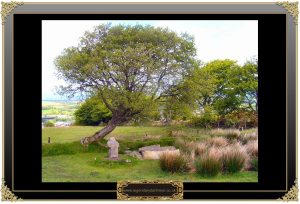
One of the perils of walking across the moor at night is possibility of meeting with the pixies or as the moorfolk call them ‘piskies’. There are numerous stories of unfortunate people that have met them and become ‘piskie led‘. This is where the mischievous piskies envelop the traveller in a mist which leads to them becoming lost and wandering around in aimless circles and unable to get off the moor. This normally lasts until daylight when the spell is broken. This was exactly what happened to a couple who were walking across the moor, some say they returning from the nearby chapel at Halstock and others that they were merely journeying late across the moor. Whatever, they came across the piskies who brought down the mist and ‘piskie led’ them round and round in circles. They knew if they could find a spring of clear water and drink some of it the spell would be broken and they could carry on with their journey. What they did not know was that if they turned their outer garments inside out this too would have broken the spell and saved them the trouble of searching for a clear spring. As luck would have it they stumbled across a clear spring and partook of its waters, immediately the mist lifted and they could see Okehampton lying below and were able to make their way safely of the moor. The man was so grateful for having escaped such an ordeal that he erected a stone cross by the spring as a testament to their delivery. The well soon became known as a magical well and on Easter morning any youngster visiting the well could learn their destiny. There was also a recorded tradition that on the morning of Easter Sunday for young people of Okehampton to gather at the cross, presumably to greet the sunrise?
Today the well is covered over by several granite slabs but the small cross still stands alongside it. Crossing, p.122 mentions an account of a man called Bridges who suggested that the cross was brought to the well from the nearby ruined chapel at Halstock however he is a bit sceptical as to its accuracy, a point Faull, p.56 agrees with. In 1889 the following also was written; “Nearly on the ridge of the park, a small spring having a cross of rude sculpture lying in its ooze, has obtained this appellation… The cross, with an inscription denoting the care piety had taken of such places was common in older times; but there is a tradition, though we do not vouch for its authenticity, that this cross has been removed from its position over Halstock Chapel.” – Knight, p.74. It is also interesting to note that in Chudleigh’s sketch of the cross taken from his book of 1892 that the cross is indeed “lying in its ooze.” – see below. However, back to the origins of the cross, Harrison, p.294 takes a differing view as he considers that the account of Bridges “ties in with the apparent age of the cross“, this is a brave statement as a dating method for granite artefacts has never been devised, if it had it would solve many mysteries concerning the age of Dartmoor crosses. For the present we must accept that there is a stone cross at the well one of the earliest mentions of it is that of William Crossing. Interestingly enough, J. Ll. W. Page, p.65 also mentions the cross and describes it as “… the head and part of the shaft of an old cross.”, he also comments that the well is also locally known as ‘Spicer’s Well’, this being a local corruption of ‘Fitz’s Well’. This information he attributes to Crossing which considering this book was published in 1895 must make Crossing’s description one of the earliest. The vital statistics of the cross are that today it stands at a height of 84 centimetres with an arm span of 49 centimetres and a circumference of 1.08 metres – Sandles, p.38. As can be seen from the 2019 photograph below sadly the rushes are slowly encroaching around the cross and well, maybe it could do with a touch of TLC?
There are a couple of records of the well, the first was in the September of 1676 when one Richard Shebbeare noted that “There was not any water to be seen at Fitze well, the summer soe hot and dry“, The second being Page, p.64 where he describes “cattle slaking their thirsts” and “soldiers watering their horses” at the well. Having visited the well in May 2005, as can be seen from the picture below it is still issuing copious amounts of water, albeit on the downhill side of the well and judging from the hoof marks livestock still slake their thirsts at the spring.
So where did the name of ‘Fitz’ come from? Again Crossing, p.122 is the originator of the theory that John Fitz was the owner of Okehampton Park where the well is situated. He also owned lands in Tavistock the centre of which was Fitzford. He also records that Mr Bray called him a “water fancier” because in the mid to late 1500’s he leased some land with the rights to convey water “in pipes of timber, lead or otherwise” to his house at Fitzford”. Crossing also suggests several spellings for the name Fitz; there is Fytz, Fitz, Fice, and Fize. and Fice is also the name for the well that John Chudleigh uses in his book of 1892., p.62. Now it gets confusing, on the land which had the water lease there is another well called Fice’s Well. This well has a date of 1568 inscribed on a tablet and also has an identical story of a couple getting piskie led and drinking pure spring water to break the spell, only this time the couple are John Fitz and presumably his wife. So now we have two wells, both with the same legend and both owned by the same man with a differently spelt surname. Therefore is it possible to conclude that if Fitz and Fice were the same man and he built Fice’s Well in 1568, Fitz’s Well must have been established around about the same time?

Chudleigh, J. 1892. An Exploration of Dartmoor’s Antiquities. Pembury: J. Pegg Pub.
Crossing, W. 1987 The Ancient Stone Crosses of Dartmoor, Devon Books, Exeter.
Faull, T. 2004 Secrets of the Hidden Source, Halsgrove, Tiverton.
Harrison, B. 2001 Dartmoor Stone Crosses, Halsgrove, Tiverton.
Knight, W. H. T. (Ed), 1889, Account of the Town of Okehampton, Tiverton: W. Masland.
Page, J. Ll. W. 1895 An Exploration of Dartmoor, Seeley & Co, London.
Sandles, T. 1997, A Pilgrimage to Dartmoor Crosses, Forest Pub. Liverton.
 Legendary Dartmoor The many aspects past and present of Dartmoor
Legendary Dartmoor The many aspects past and present of Dartmoor




Does anyone have the directios on how to get to fitz’s well? By car n foot from Paignton. Best way please
Drive to Okehampton, in the centre turn right at the traffic lights and follow the sign to the railway station. keep going up hill and when you enter the moor the Fitz’s Well is on the right.
In Crossing’s book, Tales of the Dartmoor Pixies, he says on p58 that the well is near Princetown. Are there two??
What happened to all the property